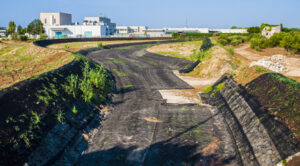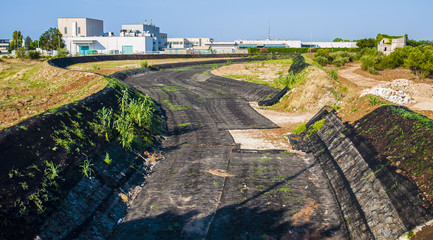Whether for eco-conscious construction or compliance with local ordinances, effective erosion control keeps sediment and pollutants from exiting the site and entering adjacent waters or public rights-of-way. This requires installing and implementing functional best management practices. These practices include estimating sediment yield, designing shorter and flatter slopes, and using vegetation with deep-rooted systems to reduce erosion.
 Weather can affect the rate and extent of erosion. Heavy rains or windy conditions can accelerate erosion and increase the amount of sediment carried off a construction site and into nearby waterways. Sediment can pollute natural water systems and reduce the quality of drinking water. Erosion Control Charleston SC help to minimize the potential for sediments to enter sewer systems and natural watersheds.
Weather can affect the rate and extent of erosion. Heavy rains or windy conditions can accelerate erosion and increase the amount of sediment carried off a construction site and into nearby waterways. Sediment can pollute natural water systems and reduce the quality of drinking water. Erosion Control Charleston SC help to minimize the potential for sediments to enter sewer systems and natural watersheds.
The effects of climate change on soil erosion are also under investigation. Climate change is expected to result in increased rainfall intensity, higher stream velocities and decreased soil moisture content. These changes are predicted to increase the erosive power of rainfall and lead to an increase in sediment load in stream channels, rivers and lakes.
In order to develop a better understanding of how these changes will affect erosion, researchers are studying the behavior of rills and sheet erosion using computer models. The computer models are able to predict the erosion of individual soil particles and provide insight into the effect of climate change on sediment movement.
This modeling is done through the use of a computer program called GloSEM. The model uses data collected from satellite sensors and atmospheric models to generate maps of erosion rates across the globe. The results of this analysis can be used to guide future research and development of erosion control practices.
The erosion rates measured by the model are compared to those observed in field experiments using erosion control methods. The results of the modeling indicate that erosion rate increases with increasing rainfall intensity and decreases with decreasing soil moisture content. The results also show that erodible slopes are more prone to erosion than undisturbed slopes.
Erosion control techniques are often used during construction projects to protect the soil surface from wind and water erosion. Some of these techniques include silt fences and sediment basins. Erosion controls are also frequently used to prevent stormwater from carrying loose soil off the jobsite and into nearby bodies of water. Erosion controls are often incorporated as part of the construction stormwater management plan required by local ordinances. For large and complex jobs, a preconstruction conference should be held to discuss the erosion control plans and schedule with all involved parties. The erosion control representative should attend this conference to ensure that all aspects of the project are properly coordinated.
Soil Texture
Soil texture relates to the proportions of sand, silt and clay particles in a soil mass. It influences how the soil is worked, the amount of water and air it holds and how easily it drains.
The texture of a soil can be determined in the field by hand texturing a small amount of the soil and analysing it for colour, feel, sound and cohesiveness. To hand texture a soil, first remove all the gravel and root material from a sample of the soil. Then wet the sample and form it into a ball called a bolus. Once the bolus is formed it should be slightly coherent and sticky to touch. Then press and squeeze the bolus to determine the soil texture. A sandy soil will have a light feeling to it and single sand grains will stick to your fingers. A silty soil will have a spongy texture and may be coloured if there is a lot of organic matter present. A clay soil will have a firm feel and be quite greasy to the touch.
While this method takes practice, it is a good way to estimate the soil textural class in the field and is used for most field-based soil descriptions. A more precise determination of the textural class can be made in the laboratory using particle size analysis which determines the percentage of sand, silt and coarser sized particles in the soil.
Soil structure also affects the rate of erosion. Coarse textured soils are more resilient than finer textured soils as they contain a higher percentage of granular components that hold together better and resist movement. On the other hand, finer textured soils have smaller pores that allow water to enter and move more readily through the soil.
When soils with different textures meet or overlay each other, they may restrict the flow of water through one texture to the other, even when saturated. This is most likely to occur where a coarse-textured soil overlies a fine-textured soil because the larger pore sizes of the coarse-textured soil restrict the flow of water into the fine-textured soil.
Rock Types
There are three broad categories of rock: igneous, sedimentary and metamorphic. Minerals are naturally-occurring inorganic solids that combine chemically to form a rock. Rocks are formed of minerals with a specific chemical composition and an ordered crystalline arrangement. It is the minerals in a rock that determine how easily it erodes and weathers.
Igneous rocks erode very slowly. They are composed of crystals that interlock and increase the strength of the rock. Examples include basalt and gabbro. Gabbro is an intrusive igneous rock that forms through the slow cooling of magma that is rich in irons and magnesium. It is darkly colored and has a distinct appearance.
Sedimentary rocks erode more quickly. They are composed of material such as sand, gravel, clay and silt that have been compacted and cemented to become sedimentary rock. Sedimentary rocks erode at a rate of 2-6 cm per year.
Streams and river beds are the fastest erosion producers on Earth. They carry sediments downstream particle by particle. The force of the current erodes banks, cuts channels and transports the material to bays. Breaking waves, currents and ice can also erode coastlines by dislodging and transporting sediments.
Metamorphic rocks erode at a slower rate than igneous and sedimentary rock. They are characterized by layers or bands of different rock types that make up the rock. The rock types are arranged in a pattern known as foliation. Some examples of metamorphic rocks are slate, marble and schist. Metamorphic rocks erode at a rate of 1mm to 10cm per year.
In addition to the size and texture of a rock, its shape is important to its erosion potential. Angular rocks tend to hold together better on slopes and in fast water flow than rounded stones. They are therefore better for erosion control.
Complex cliff profiles with alternating layers of hard and soft rock are called concordant or discordant coastlines. The underlying rock type influences how fast the coast erodes. If the softer rock is eroded, a cove will form (see Lulworth Cove). The harder the rock, the slower the erosion.
Vegetation
Vegetation acts as a physical barrier to erosion. It intercepts rainfall, reduces splash and sheet erosion, and anchors soil with its roots. Vegetation can also be used to dissipate energy, slow runoff and reduce sediment yield. The type of vegetation selected depends on site conditions, including soil types, slope, climate and topography.
Vegetative cover is especially important in the presence of erodible soils. It increases groundwater recharge, improves moisture holding capacity and nutrient availability, and decreases surface water erosion by acting as a natural filter. Vegetation is often a critical component of any erosion control program, and it is the most important factor in protecting soils on a long term basis.
Often, sediments wash away in stormwater or floodwaters and carry contaminants such as paint, solvent and adhesive residues from construction sites. These pollutants can diminish water quality, affix themselves to other soils and stunt plant growth. Sediment-control measures, such as RECPs (Erosion Control Practices), can help prevent sediments from leaving a construction site.
Erosion is less costly to control when it is prevented rather than removed after it has deposited somewhere else. A few effective sediment-control practices can make a significant difference in the cost of construction.
Generally, longer and steeper slopes erode more rapidly and produce more sediment than shorter and flatter slopes. The use of benches and steps, along with some soil bioengineering methods, can reduce slope length and angle.
Once erosion and sediment control practices are in place, construction can begin. In many cases, a preconstruction conference is recommended and sometimes required to provide an opportunity for the contractor, owner and erosion control specialist to review plans, discuss concerns and agree on responsibilities. This meeting should also include a discussion of the schedule for implementing the erosion control plan.
Identify the responsible party for maintenance and establish a maintenance schedule based on site conditions, design safeguards, construction sequence and anticipated weather conditions. Determine when temporary practices will be removed, how debris and sediment will be handled and how these areas and waste disposal areas will be stabilized once they are no longer needed.

